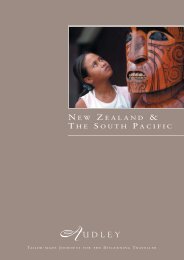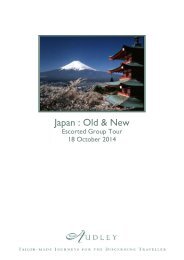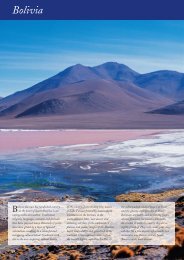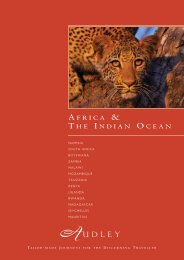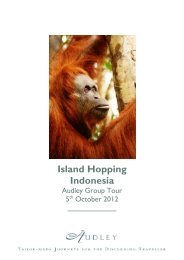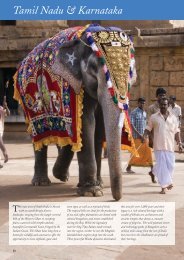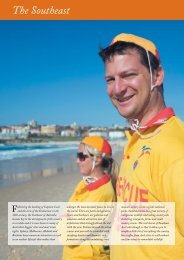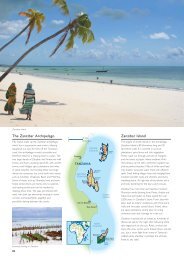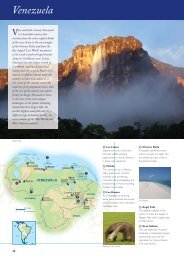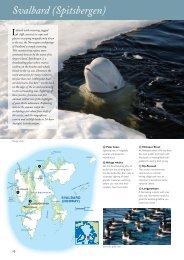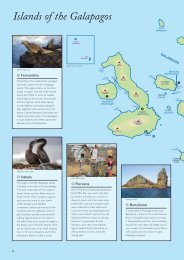Download - Audley Travel
Download - Audley Travel
Download - Audley Travel
You also want an ePaper? Increase the reach of your titles
YUMPU automatically turns print PDFs into web optimized ePapers that Google loves.
Wintersports<br />
Some of the world’s best skiing and<br />
snowboarding and, in particular, powder<br />
snow are to be found in the ski resorts of<br />
Hakuba in Honshu and Niseko and Furano<br />
in Hokkaido. The ski season lasts from<br />
December until April, with guaranteed snow<br />
throughout. There are ski and snowboarding<br />
runs for all levels of experience, plus some<br />
off-piste and night skiing. Each resort has the<br />
usual range of alpine hotels, self-catering<br />
lodges and small family-run guesthouses,<br />
suitable for a variety of budgets. Skiing in<br />
Japan is relatively cheap in comparison with<br />
some of the top European and American<br />
destinations, and travelling with ski equipment<br />
is simple and cost-effective. Japan’s reliable<br />
public transport system means that travel<br />
between airports or train stations and resorts<br />
is quick and keeps costs to a minimum.<br />
Other key ski and snowboarding resorts in<br />
Japan include Shiga Kogen, which is one of<br />
the world’s largest ski centres, and Nozawa<br />
Onsen, both located in Nagano prefecture<br />
on Honshu island. One of the best things<br />
about skiing in Japan is that most<br />
accommodation has hot spring bathing<br />
facilities. Combined with steaming hot pot<br />
dinners made with the freshest ingredients,<br />
there really is no better form of apres-ski.<br />
Skiier, Niseko<br />
Winter crab nabe (hot pot)<br />
Winter bather, Hokkaido<br />
Sendai & Matsushima<br />
Tohoku’s largest and most cosmopolitan city,<br />
Sendai, is the ideal staging post for exploration of<br />
the region’s more southerly highlights. Beyond the<br />
annual spectacular of the August Tanabata<br />
Festival, the city has little to keep the visitor for<br />
long, but within easy reach are the picturesque<br />
pine-clad islands of Matsushima Bay, designated as<br />
one of Japan’s ‘three great sights’. A gentle boat<br />
trip here allows visitors to experience first-hand<br />
the magical scenery that is said to have struck<br />
dumb Japan’s foremost poet, Bassho.<br />
Dewa-sanzan<br />
Dewa-sanzan is the collective name for the three<br />
holy mountains of Haguro-san, Gas-san and<br />
Yudono-san. The mountains gained their holy<br />
status over 1,400 years ago after the son of the<br />
reigning emperor made a pilgrimage to the area<br />
to practice severe aesthetic religious exercises<br />
which later became the founding principles of<br />
Shugendo Buddhism. Shugendo is an ancient<br />
blend of esoteric Buddhism, Chinese Taoism<br />
and Shinto deity worship and is practiced by<br />
the Yamabushi mountain priests, who link their<br />
religious practices strongly with the nature of the<br />
mountains. The Yamabushi are easily recognisable<br />
thanks to their distinctive garb of checked<br />
overshirts, billowing white trousers, straw sandals<br />
and small, peaked hats. The monks are now<br />
scattered all over the three mountains and you<br />
will most likely catch a glimpse of one scurrying<br />
up the mountain or at one of the many temples<br />
in the area. Dewa-sanzan is best explored over a<br />
number of days as there are some strenuous<br />
climbs, but if your time is more limited, then we<br />
recommend a hike to the top of either Mount<br />
Haguro or Mount Gas-san, both of which are<br />
around two hour ascents.<br />
Lakes and hot springs<br />
Much of Tohoku was once volcanic, resulting<br />
today in a number of scenic lakes and countless<br />
natural onsen resorts. With a hire car it is easy to<br />
strike out to Lake Towada in the north, one of<br />
Honshu’s most scenic lakes. Towada is hugely<br />
popular with local visitors during the turning leaf<br />
koyo season from mid-October, when the beech<br />
and maple-clad hillsides of the Oirase Valley turn<br />
spectacular shades of gold and crimson. From<br />
there, travel south to secluded onsen such as<br />
Aoni and Nyuuto, and then on to Tazawako,<br />
Japan’s deepest lake. In winter this region lies<br />
beneath metres of snow, but the lake never<br />
freezes, thanks, according to local legend, to the<br />
fiery dragon that lives beneath its surface.<br />
TSURUNOYU, NYUUTO ONSEN<br />
The Tsurunoyu ryokan is the oldest and most<br />
authentic ryokan in the area. It is truly enchanting,<br />
serving traditional food consisting of local<br />
mountain vegetables and fish cooked over a small<br />
irori fire pit, and offering an excellent outdoor<br />
onsen. There are several baths at the Tsurunoyu,<br />
each fed by a different source of water. There is<br />
also a large outdoor mixed-sex bath, which you<br />
are welcome to try if you are brave enough, but<br />
please do observe local etiquette! See page 13<br />
for more information on Japanese customs.<br />
Ancient pagoda, Mount Haguro<br />
www.audleytravel.com/japan ● 01993 838 210 ● Northern Japan 25



